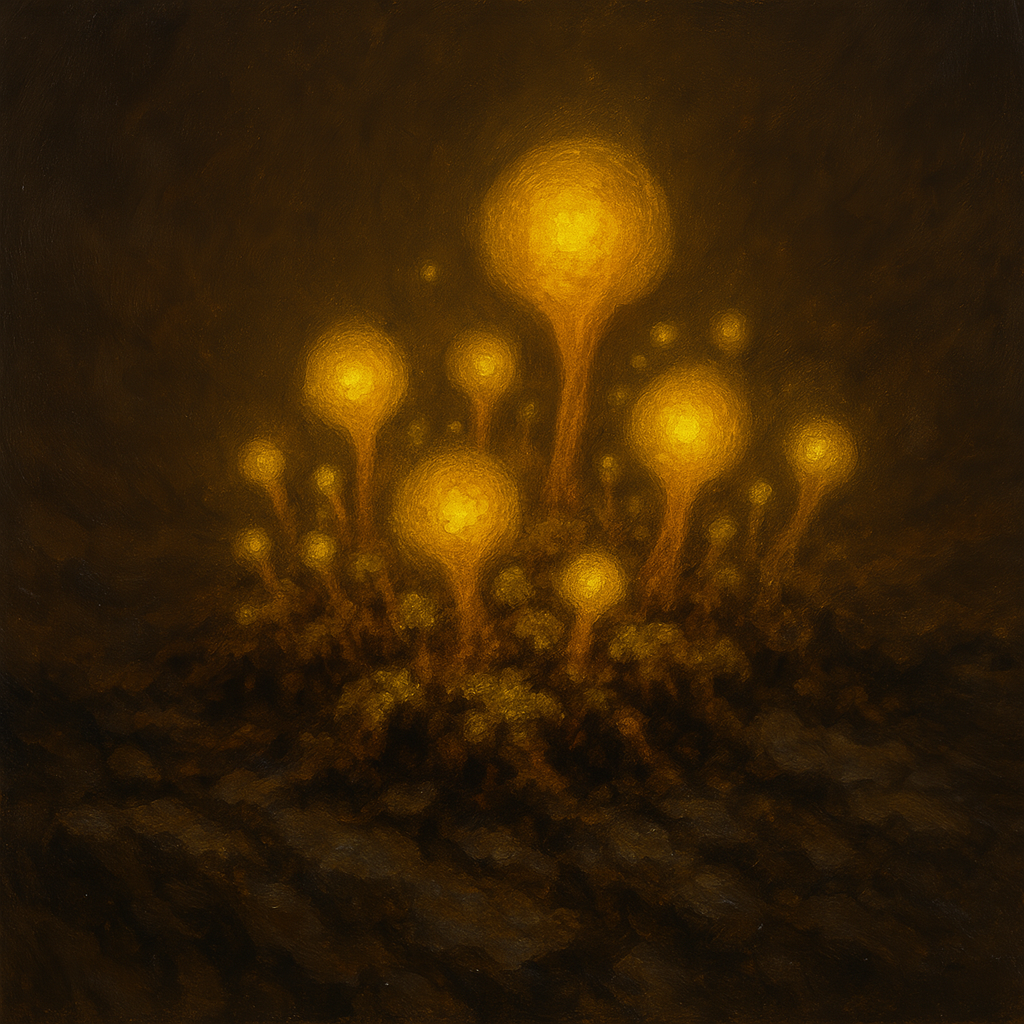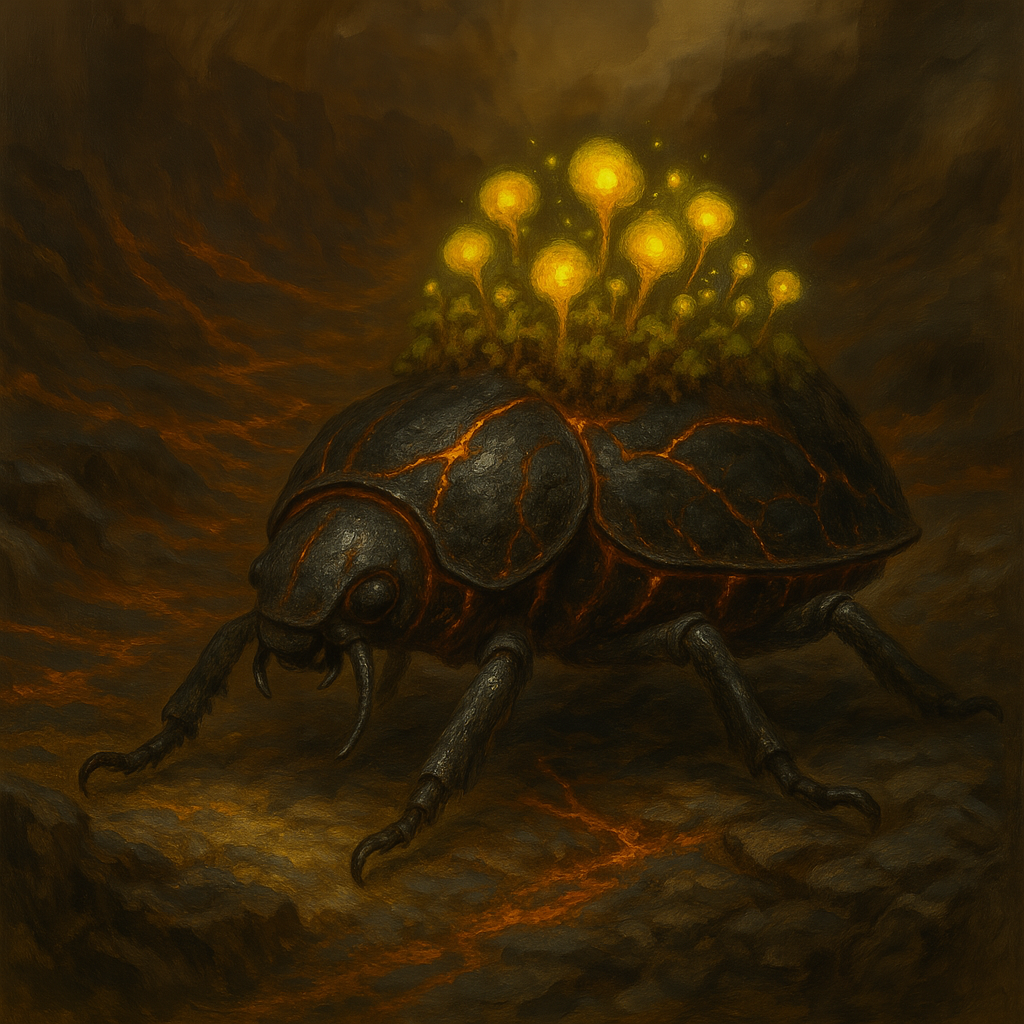Scorchback Beetle
A hardy, fist-sized beetle native to volcanic regions like Drakoria or the Sulfire Reaches, the Scorchback Beetle survives through a symbiotic relationship with a specialized heat-resistant fungus known as Ashroot Mold.
The beetle’s cracked obsidian-like shell is streaked with glowing orange fissures, a result of constant geothermal exposure. It feeds on volcanic minerals and sulfur deposits—but can’t digest them alone. Instead, colonies of Ashroot Mold grow along its back and underside, breaking down the minerals into usable nutrients. In return, the beetle protects the mold, carries its spores across lava flows, and creates burrows in sulfur-rich stone for it to thrive.
Basic Information
Anatomy
The Scorchback Beetle is a compact, fist-sized insect with a body built for survival in extreme volcanic environments. Its most distinctive feature is its dense, obsidian-like exoskeleton, matte black in color and crisscrossed with glowing orange fissures. These fissures aren’t just cosmetic, they’re part of the beetle’s heat-regulation system, allowing excess internal warmth to vent safely while creating an intimidating visual display. This heat shimmer, combined with the beetle’s hardened shell, deters most predators from even attempting to engage.
Along its back grows a colony of Ashroot Mold, a heat-resistant, bioluminescent fungus that forms a symbiotic relationship with the beetle. The fungus appears as a spongy, earth-toned mat speckled with glowing golden bulbs. It breaks down the mineral-rich detritus the beetle consumes, such as sulfur, obsidian dust, and metal flakes, into digestible nutrients. In return, the beetle protects the fungus and spreads its spores by burrowing and traversing fresh volcanic soil.
The Scorchback’s six segmented legs end in sharp, hooked claws ideal for navigating rocky cliffs and cooled lava flows. Its movement is slow and deliberate but incredibly stable, once anchored, it is nearly impossible to dislodge. Its mandibles are short and blunt, designed for crushing porous rock and scraping mineral buildup, while a tongue-like grooming appendage helps harvest nutrients from its fungal partner.
Though not built for speed or flight, the beetle has sophisticated internal spiracles, tiny, heat-venting pores hidden beneath its armor plates. These allow it to release steam or bursts of hot gas when threatened, creating a small defensive blast. Its sensory organs are limited but efficient: wide compound eyes tuned to detect thermal shifts and low-light environments help it navigate even the darkest lava tubes.
In most mature beetles, the antennae are vestigial or entirely absent, burned away during molting or rendered obsolete due to environmental adaptation. Juvenile instars retain short antennae early in life, but these are shed as the beetle adapts to life in high-temperature zones.
Additional Information
Symbiotic and Parasitic organisms
The Scorchback Beetle’s most vital symbiotic partner is Ashroot Mold (Mycothermus symbiosa), a heat-resistant fungus that grows along the beetle’s dorsal carapace. This relationship is essential to the beetle’s survival, as it relies on the fungus to break down sulfur, volcanic minerals, and trace metals into nutrients it can absorb. In return, the mold benefits from the beetle’s mobility, using its constant movement across lava flows and mineral-rich soils to spread spores into new territory. The beetle also shields the mold from predators and provides a stable, warm substrate on which it can thrive.
Another, more passive symbiotic relationship exists with the Emberfly (Pyrahelia lucens), a tiny bioluminescent insect that feeds on the spores produced by Ashroot Mold. While the beetle gains no direct benefit from the emberflies, their presence helps spread fungal spores over a wider area and may also extend the beetle’s territorial scent by spreading the mold’s pungent defense compounds. Most beetles tolerate these hitchhikers, though some actively repel them by releasing short bursts of heated steam.
Conversely, the Scorchback Beetle does face parasitic threats. The most notable is the Moltworm (Vermis incedens), a burrowing lava-dwelling larva that seeks out juvenile Scorchbacks during molting. The Moltworm slips beneath the softening plates of a shedding beetle and feeds on its blood and partially formed fungal mats, often weakening or killing the beetle before it can complete its molt. Some adult Scorchbacks have developed a behavioral adaptation, hiding in sulfur vents or burying themselves during vulnerable molting phases to avoid Moltworm detection.
Scientific Name
fungivorax
Lifespan
8–12 years in the wild
In captivity, well-tended specimens can live up to 15 years, especially when kept near geothermal vents and provided a proper mineral substrate.
In captivity, well-tended specimens can live up to 15 years, especially when kept near geothermal vents and provided a proper mineral substrate.
Conservation Status
Stable Regionally Monitored
Scorchback Beetles are resilient and well-adapted to their volcanic habitats, making them difficult to eradicate even by accident. However, their reliance on Ashroot Mold means that areas where the fungal colonies have been overharvested for alchemical use can see localized population collapse.
Scorchback Beetles are resilient and well-adapted to their volcanic habitats, making them difficult to eradicate even by accident. However, their reliance on Ashroot Mold means that areas where the fungal colonies have been overharvested for alchemical use can see localized population collapse.
Average Height
15 cm (6 inches)
Average Weight
2.5–3.2 kg (5.5–7 lbs)
Despite its size, it’s dense and heavy due to its mineral-rich exoskeleton and fungal symbiont mass.
Average Length
25–30 cm (10–12 inches)
Geographic Distribution






Love this lava-creepy-mushroom-insectoid friendship, I had a good time reading it
Thank you! I'm glad you liked it. I was set on doing some kind of fungi for this prompt I just wasn't sure how.
"Every story is a thread, and together we weave worlds."
The Origin of Tanaria